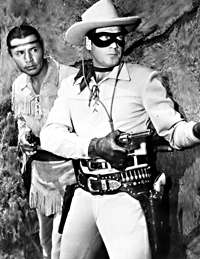“A fiery horse with the speed of light, a cloud of dust, and a hearty “Hi-yo, Silver!”
Who was that masked man? Of course, it had to be The Lone Ranger, star of a TV series set in the Old West that aired in primetime on ABC from 1949 to 1957 and was hugely popular with both kids and adults. The Lone Ranger, whose real name on the show was John Reid, was portrayed by actors Clayton Moore and, for a short time, John Hart, while Jay Silverheels played Tonto, the Lone Ranger’s loyal Native-American friend.
Based on an earlier radio series, the show’s premise, which was dramatized in the series’ first few episodes, was that John Reid was the only one of six Texas Rangers to survive a canyon ambush by a murderous gang of criminals. Reid’s childhood friend Tonto comes upon the massacre and discovers Reid is still alive, though just barely. Many years earlier, Reid had rescued Tonto after renegade Indians had murdered his mother and sister and left him for dead. At that time, Reid had given Tonto a horse, and Tonto had insisted that Reid accept a ring. Tonto recognizes Reid by this ring when he comes upon the scene of the ambush.
Tonto takes Reid to safety and nurses him back to health. Reid vows to devote his life to bringing the killers and others like them to justice. He decides this will be easier if his identity is hidden, so when Tonto buries the dead Rangers, Reid asks Tonto to dig a sixth grave so people will believe that he, too, died in the ambush. Unfortunately, one of the gang members returns to the scene and tries to kill Reid and Tonto so he can take Tonto’s horse, Scout. But he falls to his death while trying to drop a rock on Reid, so now Tonto is the only person who knows that Reid is still alive.
Reid and Tonto come upon a magnificent white stallion that has been injured by a buffalo. They nurse the stallion back to health, and Reid adopts the stallion as his mount, calling him Silver. Whenever the Lone Ranger gets read to gallop away on Silver, he shouts, “Hi-yo, Silver! Away!”
Tonto makes Reid a mask out of material cut from the vest of Reid’s brother, one of the murdered Texas Rangers, which allows him to create a new identity as the Lone Ranger. He decides to use only silver bullets in his gun, to constantly remind himself that life, like silver, is precious and valuable, and not to be wasted or thrown away. From that day on, vowing to fight for justice and never to shoot to kill, the Lone Ranger and Tonto wander the Old West helping people and fighting injustice.
Like Superman and Batman, the premise of The Lone Ranger revolved around the main character’s hidden identity, which meant that John Reid, like Clark Kent and Bruce Wayne, didn’t seek and never got the thanks he deserved for helping people. At the end of each episode, the Lone Ranger and Tonto would ride away as one of the characters they had helped would lament the fact that they never learned the hero’s name (“Who was that masked man?”), only to be told, “Why, he’s the Lone Ranger!”
The show’s signature theme music was the finale of Rossini’s William Tell Overture, which became inseparably associated with the series. Even now, I can’t hear the Overture without picturing the Lone Ranger seated on Silver as the magnificent horse rears up and paws the air with his front hooves.
Like other cowboy shows, The Lone Ranger was a family-oriented series designed to teach lessons about morals and values to its viewers. It was the Lone Ranger’s strict moral code that enabled him to prevail over the bad guys who preyed upon the good people of the Old West. Though Native-Americans were the stereotypical enemy in many other Westerns, The Lone Ranger’s partnership with Tonto showed that respecting the rights and beliefs of others was an important part of his moral code and one of the lessons that the show tried to teach. Much of The Lone Ranger TV series is available on DVD. Some good collections are:
- The Lone Ranger: 75th Anniversary, Seasons 1 and 2, a 13-disc collector’s edition
- The Lone Ranger, a boxset with 19 of the later (1956/57) color episodes
- Lone Ranger Collection, a 2-DVD set with 17 early episodes


Recent Comments